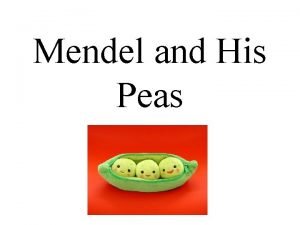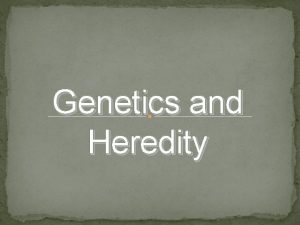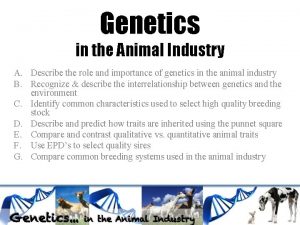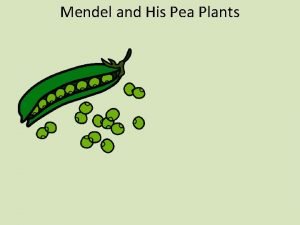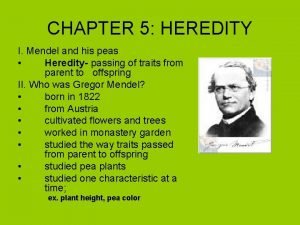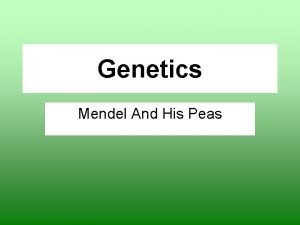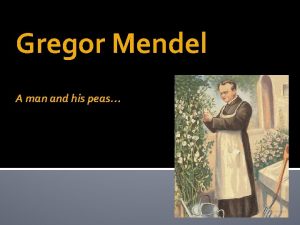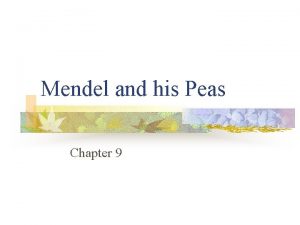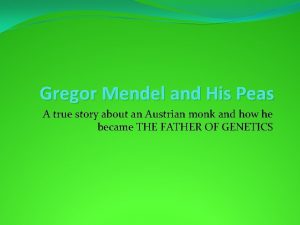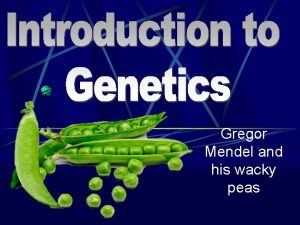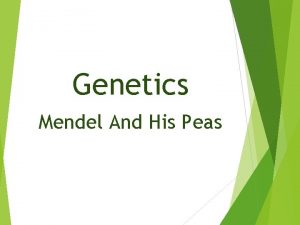Mendel and his Peas The passing of traits

















- Slides: 17

Mendel and his Peas

The passing of traits from parents to offspring.


Gregor Mendel • • Born 1822 in Austria At 21 became a monk Went to school in Vienna Conducted his own scientific investigations in the monastery garden.

Mendel’s Experiments • Kept them simple and “controlled” • Kept very good records • Worked with pea plants

Mendel’s Experiments continued… • He observed characteristics including seed shape, plant height and flower color. • Only observed one characteristic at a time. • A characteristic is a feature that has different forms in a population. • Traits are the different forms that a characteristic can take.

Mendel’s First Experiment • Created true-breeding plants before he started his experiments (He did this by breeding the plants for many generations until he always got the expected results. ) • When one true-breeding plant self pollinates all of the offspring will have the same traits as the parent.

Mendel’s First Experiment continued… • He crossed (cross pollinated) truebreeding purple flowers with true-breeding white plants. • He removed the anthers of one plant to make sure that they cross pollinated.

All of the offspring were purple

Mendel’s First Experiment continued… • The purple flower was always present while the white flower seemed to disappear. • He said the purple flowers was a dominant trait and the white flower was a recessive trait.

The same was true for the pea pod experiments.

Mendel’s Second Experiments • He allowed the first generation plants (offspring of the first experiment) to self pollinate. • The recessive trait reappeared in the second generation. • He noticed a 3: 1 ratio of the dominant to recessive traits. • This ratio showed the relationship between two different things (traits)

Mendel realized… • His results could only be explained if each plant had two sets of instructions for each characteristic. • Each parent would donate one set of instructions but only one would show up in the offspring.

Use a Punnett Square to calculate the probability that offspring with a certain characteristic will result.

First Generation (two true breeding parents)

Second Generation (both parents are not true breeding)

 Mendel and his peas
Mendel and his peas Mendel and his peas lesson 1
Mendel and his peas lesson 1 Mendel traits
Mendel traits Gregor mendel video
Gregor mendel video Section 11-1 the work of gregor mendel
Section 11-1 the work of gregor mendel Quantitative and qualitative traits
Quantitative and qualitative traits Qualitative traits vs quantitative traits
Qualitative traits vs quantitative traits Qualitative traits vs quantitative traits
Qualitative traits vs quantitative traits Elizabeth picks up the clothes from her bedroom floor
Elizabeth picks up the clothes from her bedroom floor Lady macbeth soliloquy analysis
Lady macbeth soliloquy analysis Louie his cousin and his other cousin
Louie his cousin and his other cousin Caged bird poem metaphor
Caged bird poem metaphor Driving beam vs passing beam
Driving beam vs passing beam Tom minka
Tom minka Token passing advantages and disadvantages
Token passing advantages and disadvantages Hình ảnh bộ gõ cơ thể búng tay
Hình ảnh bộ gõ cơ thể búng tay Frameset trong html5
Frameset trong html5 Bổ thể
Bổ thể
